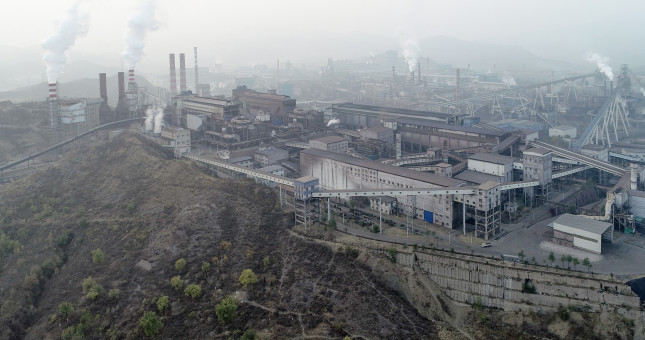-
The Ukraine War’s Shadow on China’s Road to Decarbonization
May 26, 2022 By Jeremy L. WallaceRussia’s invasion of Ukraine has shaken the world economy. The U.S.-led push for sanctions on Russia has surprised analysts with its depth. Germany, for example, is now turning away from four decades of reliance on Russian oil and gas. Given Russia’s status as a global energy colossus, the war has raised particular uncertainty in global energy markets, leading many countries to take steps to ensure adequate supplies.
China’s energy connection to the crisis and, specifically, the war’s effect on China’s decarbonization commitments, have drawn little attention. Unfortunately, the war’s impact on energy markets has accelerated Chinese plans to return to the use of coal for power generation. And the market volatility it has inflamed is partly behind China’s return to investment-and emissions-heavy stimulus. Make no mistake, however, China’s investments in renewables are still enormous and dwarf those of the United States.
China paying more for imported energy
Russia’s war on Ukraine has aggravated global inflationary pressures. The Russian invasion has made many countries leery of purchasing Russian fuels; the resulting reduction in available energy supplies has led to higher prices for oil, gas, and coal. Turbulence in the world economy, partly owing to the war and partly to other factors, has also led to higher prices for some metals needed for a clean energy transition.
China is a major importer of energy so price increases have a direct effect on its trade balance. Before the war, China imported significant oil and gas from Russia, along with some coal. After the start of the war, China sent ambiguous signals, with state-owned refineries initially shunning new contracts, presumably because of foreign policy concerns and the threat of future sanctions. However, the lower price of Russian oil, which sells at a $30 per barrel discount compared to benchmark prices, has proven irresistible. Over the past few weeks, Chinese state-owned firms have joined independent refiners (and India, which has openly been buying cheaper Russian oil) in securing additional supplies in quiet deals in the face of sky-high prices for energy.
Blackouts already cast a shadow on decarbonization efforts
So, China seems willing to risk potential sanctions to maintain access to Russian energy, but how does the war affect China’s plans for decarbonization? China had already stepped back somewhat from ambitious plans to rely on renewables for new power generation partly because in Fall 2021, China was hit by a wave of blackouts and forced load-shedding. In China, coal prices fluctuate based on supply and demand, but electricity prices are strictly regulated. As coal prices increased last year, coal generators were reluctant to add stockpiles, hoping for lower future prices. After a stronger than predicted economic recovery, coal supplies ran short. In the wake of this electricity system failure, China reformed its market structure to allow electricity prices to reflect costs more flexibly, but underlying issues remain.
This electricity system failure had already pushed Chinese leaders to emphasize energy security over decarbonization. The uncertainty of global markets ensuing from Russia’s attack on Ukraine exacerbated Chinese concerns. Given China’s status as the world leader in renewables and its recent dual pledges of peaking in carbon emissions in the power sector in 2030 and reaching net zero emissions by 2060, one might expect a focus on innovation and renewables. Instead we’ve seen a partial retrenchment in favor of King Coal. Beyond adding 25 GW of new coal plants to its grid in 2021, China also started new construction on 33 GW of coal generation, while the rest of the world only started 10 GW of coal plants.
Despite renewables, China’s sticking with coal
It’s no secret that coal is a huge source of greenhouse gas emissions. Beyond the obvious emissions that come from burning coal, coal mining is a massive source of methane, which has many times the impact of CO2. The economic return on constructing new coal-fired power plants is also likely to be non-existent.
Burning coal in existing plants to supplement renewable power when the sun isn’t shining or the wind isn’t blowing has an economic logic to it. Meaning, as renewables come to dominate the electricity grid in China, coal will persist in the power sector and serve as peaking plants that only run during periods of high demand of energy, similar to the role that natural gas plays in the U.S. grid. Coal now provides around 57 percent of China’s primary energy mix, but renewables have been a greater proportion of new additions to the system.
However, China’s energy system rhetoric increasingly seems to fall into the warm embrace of coal. This partly owes to the war’s effect on fragile supply chains for the energy transition. Batteries are a key element of an energy system centered on renewables, as they allow countries to reduce the need for “peaking” plants. Unfortunately, partly due to the war’s rattling of global supply chains, the price of lithium, a key component of batteries, is rising sharply. While the world has enough lithium and other metals, the long lead time between exploration and production means supplies might run short of demand in the near to medium-term. Moreover, rather than have batteries as core to the electricity grid, China seems to have made a policy choice to focus on pushing batteries to electrify transportation. Chinese policymakers seem to be banking on new coal facilities to support the remote clean energy farms, rather than shifting to batteries because of expectations of further price increases in key metals.
China’s partial shift back towards coal is disappointing as President Xi’s increasing climate change commitments had galvanized real momentum for the clean energy transition at home and abroad. While the war has spurred European investments in energy — both fossil and clean, China seems to be taking a path similar to the United States where prior green rhetoric is being overshadowed by fuel price concerns.
Despite retrenchment, China still leads in renewables
Despite indications that China is retreating from plans to move quickly away from coal, make no mistake, China is still building more renewable energy and investing more in next generation energy technologies than anywhere else. No one should underestimate China’s efforts. China plans to expand its wind and solar generation capacity by 555 GW between 2020 and 2025; the US total wind and solar in 2020 was less than 200 GW. Last year alone China added 53 GW of solar PV and another 48 GW of wind capacity. To reach the country’s carbon neutral goals, the government still plans to construct massive solar and wind farms in the remote Gobi desert, scaling up to 450 GW by 2030, enough to power 41 New York Cities everyday. Because of the scale of its investments, China has come to dominate the solar supply chain. China makes 95 percent of the wafer stage of the solar supply chain.
Jeremy L. Wallace is an associate professor of government at Cornell University, studying authoritarian politics focusing on China, cities, statistics, and climate change. His second book, Seeking Truth and Hiding Facts, will be out this fall. His recent work on COVID-19 was published in APSR and on China’s relationship with the international order in International Organization. He serves as an editor at The Monkey Cage and writes the China Lab newsletter, which focuses on the evolving political economy of China’s decarbonization.
Sources: Bloomberg, Center for Research in Energy and Clean Air, CSIS, IEA, iopScience, Neste.com, New Statesman, The New York Times, Protocol China, PV Magazine, Reuters, SupChina, Washington Post, Windpower Monthly
Photo Credit: Aerial view of factory and coal plants in Chengde China, courtesy of Unwind/shutterstock.com.
 A Publication of the Stimson Center.
A Publication of the Stimson Center.







